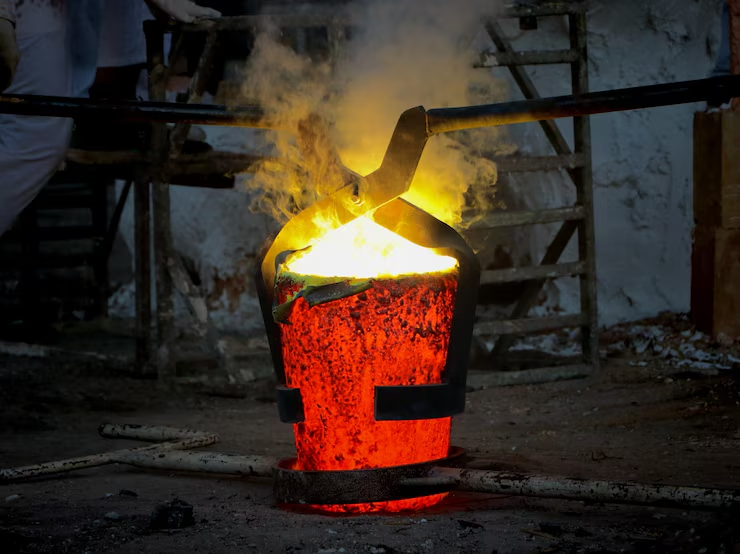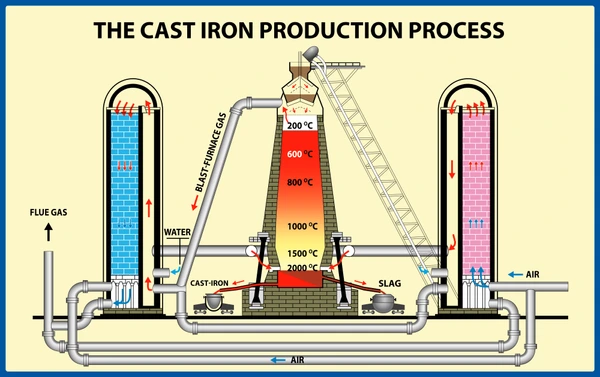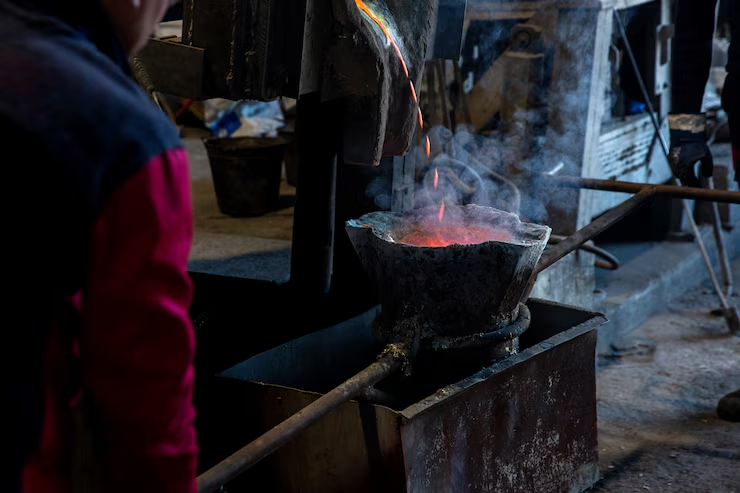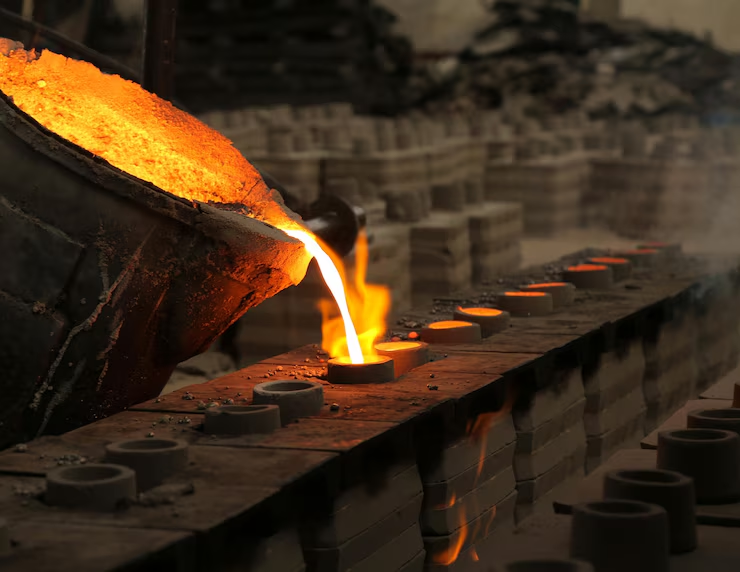Iron plays a vital role in the modern world, serving as a fundamental component in everything from skyscraper construction to the production of tools and machinery. As a material driving industrial advancement, iron and its alloys are indispensable. This in-depth article explores the process of extraction of iron, focusing on the blast furnace method. It covers the essential raw materials, the chemical reactions involved, and the environmental impact of the process. By the end, readers will gain a clear and comprehensive understanding of how iron is obtained from its ores and prepared for industrial applications.
Introduction to Iron and Its Importance

Iron (Fe) is a metallic element that is abundant in the Earth’s crust and is highly reactive in its pure form. It is rarely found as a free element and mostly occurs in iron ores such as hematite (Fe₂O₃) and magnetite (Fe₃O₄). Its strength, durability, and magnetic properties make it one of the most widely used metals on the planet.
Main Ores of Iron
To extract iron efficiently, we must begin by understanding its main ores. These are the raw materials from which iron is derived:
- Hematite (Fe₂O₃) – Contains up to 70% iron.
- Magnetite (Fe₃O₄) – Contains up to 72% iron.
- Limonite (FeO(OH)·nH₂O) – Contains lower iron content.
- Siderite (FeCO₃) is also a less rich source of iron.
Among these, hematite is the most commonly used ore for industrial iron extraction due to its high iron content and ease of reduction.
The Blast Furnace: Core of Extraction of Iron
The blast furnace is a towering structure where iron ore is converted into molten iron through a series of chemical and physical processes. The process is continuous and highly efficient, making it ideal for large-scale production.
Structure of the Blast Furnace
A typical blast furnace consists of:
- Top (Throat) – Where raw materials are fed.
- Middle (Stack) – Zone where pre-heating and initial reactions occur.
- Lower Section (Bosh and Hearth) – The hottest area where final reduction and melting take place.
Raw Materials Used in the Blast Furnace

- Iron Ore (Hematite or Magnetite) – Source of iron.
- Coke – A form of carbon that acts as a fuel and reducing agent.
- Limestone (CaCO₃) – Helps remove impurities by forming slag.
These materials are fed from the top in alternating layers to ensure continuous operation and efficient reaction.
Chemical Reactions in the Blast Furnace
The extraction of iron involves several crucial chemical reactions. These occur as the materials descend and are subjected to increasing temperatures.
1. Combustion of Coke
At the base of the furnace, hot air (blast) is introduced:
C + O₂ → CO₂
(Combustion reaction releases heat)
2. Formation of Carbon Monoxide
Carbon dioxide reacts with more coke:
CO₂ + C → 2CO
Carbon monoxide (CO) is the blast furnace’s main reducing agent.
3. Reduction of Iron Ore
Carbon monoxide reduces iron ore in multiple stages:
Fe₂O₃ + 3CO → 2Fe + 3CO₂
Fe₃O₄ + 4CO → 3Fe + 4CO₂
These reactions lead to the formation of molten iron, which accumulates at the bottom of the furnace.
4. Removal of Impurities (Formation of Slag)

Limestone decomposes due to heat:
CaCO₃ → CaO + CO₂
Then the calcium oxide (CaO) reacts with silicon dioxide (SiO₂), an impurity in iron ore:
CaO + SiO₂ → CaSiO₃ (slag)
This slag floats over molten iron, protecting it from oxidation and allowing easy separation.
Tapping the Furnace: Collecting Iron and Slag
At intervals, the molten iron is tapped from the bottom of the furnace and collected in molds to form pig iron. Slag is separately tapped off and often used in road construction and cement manufacture.
Types of Iron Produced
The form of iron produced depends on the carbon content:
- Pig Iron – High carbon content (3.5–4.5%), brittle.
- Cast Iron – Slightly lower carbon, used in engines, and pipes.
- Wrought Iron – Very low carbon, malleable.
- Steel – Controlled carbon content, strong and versatile.
Further processing in basic oxygen furnaces or electric arc furnaces converts pig iron into different types of steel for industrial uses.
Environmental Impact of Extraction of Iron

While iron is vital to our infrastructure, its extraction comes with environmental concerns:
- Air Pollution – Emission of CO₂, NOₓ, and SO₂ gases.
- Deforestation – Clearing of land for mining operations.
- Energy Consumption – Blast furnaces are highly energy-intensive.
- Waste Management – Slag and other by-products must be handled responsibly.
Modern technologies, such as carbon capture, recycling, and alternative iron-making processes (like direct reduced iron), are being developed to reduce the ecological footprint.
Role of Iron in Human History
The Iron Age
This era revolutionized agriculture, warfare, and daily life. Stronger tools meant stronger societies.
Influence on Modern Civilization
Without iron, we wouldn’t have trains, skyscrapers, or even kitchen knives. It’s the backbone of our modern world.
Innovations in Iron Extraction Technology
- Hydrogen-Based Reduction – Using hydrogen instead of carbon monoxide to reduce iron ore.
- Plasma Furnaces – Electric arc-based furnaces that require no coke.
- Carbon Neutral Steel Production – Integrating renewable energy sources to minimize emissions.
These advancements aim to make iron extraction more sustainable and environmentally friendly.
Comparison with Other Metals Extraction
Iron vs. Aluminum Extraction
Aluminum extraction is more energy-intensive. Iron wins on cost and accessibility.
Cost-Effectiveness of Iron
Iron is relatively inexpensive to extract and process, making it the metal.
Conclusion: Mastering the Process of Extraction of Iron
The extraction of iron is a complex yet highly efficient industrial process that transforms raw ore into a versatile and essential metal. The blast furnace remains the cornerstone of this operation, but modern advancements are pushing toward eco-friendly solutions. By understanding the chemical reactions, raw materials, and process flow, we can appreciate how one of the world’s most used metals is made and how its production can evolve.
What is the extraction of Iron?

Iron (Fe) is a metallic element that is abundant in the Earth’s crust and is highly reactive in its pure form. It is rarely found as a free element and mostly occurs in iron ores such as hematite (Fe₂O₃) and magnetite (Fe₃O₄). Its strength, durability, and magnetic properties make it one of the most widely used metals on the planet.
Main Ores of Iron
To extract iron efficiently, we must begin by understanding its main ores. These are the raw materials from which iron is derived:
Hematite (Fe₂O₃) – Contains up to 70% iron.
Magnetite (Fe₃O₄) – Contains up to 72% iron.
Limonite (FeO(OH)·nH₂O) – Contains lower iron content.
Siderite (FeCO₃) is also a less rich source of iron.
Among these, hematite is the most commonly used ore for industrial iron extraction due to its high iron content and ease of reduction.
The Blast Furnace: Core of Extraction of Iron
The blast furnace is a towering structure where iron ore is converted into molten iron through a series of chemical and physical processes. The process is continuous and highly efficient, making it ideal for large-scale production.
Structure of the Blast Furnace
A typical blast furnace consists of:
Top (Throat) – Where raw materials are fed.
Middle (Stack) – Zone where pre-heating and initial reactions occur.
Lower Section (Bosh and Hearth) – The hottest area where final reduction and melting take place.
Raw Materials Used in the Blast Furnace

Iron Ore (Hematite or Magnetite) – Source of iron.
Coke – A form of carbon that acts as a fuel and reducing agent.
Limestone (CaCO₃) – Helps remove impurities by forming slag.
These materials are fed from the top in alternating layers to ensure continuous operation and efficient reaction.
Chemical Reactions in the Blast Furnace
The extraction of iron involves several crucial chemical reactions. These occur as the materials descend and are subjected to increasing temperatures.
1. Combustion of Coke
At the base of the furnace, hot air (blast) is introduced:
C + O₂ → CO₂
(Combustion reaction releases heat)
2. Formation of Carbon Monoxide
Carbon dioxide reacts with more coke:
CO₂ + C → 2CO
Carbon monoxide (CO) is the blast furnace’s main reducing agent.
3. Reduction of Iron Ore
Carbon monoxide reduces iron ore in multiple stages:
Fe₂O₃ + 3CO → 2Fe + 3CO₂
Fe₃O₄ + 4CO → 3Fe + 4CO₂
These reactions lead to the formation of molten iron, which accumulates at the bottom of the furnace.
4. Removal of Impurities (Formation of Slag)

Limestone decomposes due to heat:
CaCO₃ → CaO + CO₂
Then the calcium oxide (CaO) reacts with silicon dioxide (SiO₂), an impurity in iron ore:
CaO + SiO₂ → CaSiO₃ (slag)
This slag floats over molten iron, protecting it from oxidation and allowing easy separation.
Tapping the Furnace: Collecting Iron and Slag
At intervals, the molten iron is tapped from the bottom of the furnace and collected in molds to form pig iron. Slag is separately tapped off and often used in road construction and cement manufacture.
Types of Iron Produced
The form of iron produced depends on the carbon content:
Pig Iron – High carbon content (3.5–4.5%), brittle.
Cast Iron – Slightly lower carbon, used in engines, and pipes.
Wrought Iron – Very low carbon, malleable.
Steel – Controlled carbon content, strong and versatile.
Further processing in basic oxygen furnaces or electric arc furnaces converts pig iron into different types of steel for industrial uses.
Environmental Impact of Extraction of Iron

While iron is vital to our infrastructure, its extraction comes with environmental concerns:
Air Pollution – Emission of CO₂, NOₓ, and SO₂ gases.
Deforestation – Clearing of land for mining operations.
Energy Consumption – Blast furnaces are highly energy-intensive.
Waste Management – Slag and other by-products must be handled responsibly.
Modern technologies, such as carbon capture, recycling, and alternative iron-making processes (like direct reduced iron), are being developed to reduce the ecological footprint.
Role of Iron in Human History
The Iron Age
This era revolutionized agriculture, warfare, and daily life. Stronger tools meant stronger societies.
Influence on Modern Civilization
Without iron, we wouldn’t have trains, skyscrapers, or even kitchen knives. It’s the backbone of our modern world.
Innovations in Iron Extraction Technology
Hydrogen-Based Reduction – Using hydrogen instead of carbon monoxide to reduce iron ore.
Plasma Furnaces – Electric arc-based furnaces that require no coke.
Carbon Neutral Steel Production – Integrating renewable energy sources to minimize emissions.
These advancements aim to make iron extraction more sustainable and environmentally friendly.
Comparison with Other Metals Extraction
Iron vs. Aluminum Extraction
Aluminum extraction is more energy-intensive. Iron wins on cost and accessibility.
Cost-Effectiveness of Iron
Iron is relatively inexpensive to extract and process, making it the metal.
Conclusion: Mastering the Process of Extraction of Iron
The extraction of iron is a complex yet highly efficient industrial process that transforms raw ore into a versatile and essential metal. The blast furnace remains the cornerstone of this operation, but modern advancements are pushing toward eco-friendly solutions. By understanding the chemical reactions, raw materials, and process flow, we can appreciate how one of the world’s most used metals is made and how its production can evolve.
What is the role of limestone in the blast furnace?
Limestone decomposes due to heat:
CaCO₃ → CaO + CO₂
Then the calcium oxide (CaO) reacts with silicon dioxide (SiO₂), an impurity in iron ore:
CaO + SiO₂ → CaSiO₃ (slag)
This slag floats over molten iron, protecting it from oxidation and allowing easy separation.
Why is coke used instead of coal?
Can iron be extracted without a blast furnace?
Is iron extraction bad for the environment?
What industries rely heavily on extracted iron?
Explain the extraction of iron.
Iron plays a vital role in the modern world, serving as a fundamental component in everything from skyscraper construction to the production of tools and machinery. As a material driving industrial advancement, iron and its alloys are indispensable. This in-depth article explores the process of extraction of iron, focusing on the blast furnace method. It covers the essential raw materials, the chemical reactions involved, and the environmental impact of the process. By the end, readers will gain a clear and comprehensive understanding of how iron is obtained from its ores and prepared for industrial applications.

Iron (Fe) is a metallic element that is abundant in the Earth’s crust and is highly reactive in its pure form. It is rarely found as a free element and mostly occurs in iron ores such as hematite (Fe₂O₃) and magnetite (Fe₃O₄). Its strength, durability, and magnetic properties make it one of the most widely used metals on the planet.
Main Ores of Iron
To extract iron efficiently, we must begin by understanding its main ores. These are the raw materials from which iron is derived:
Hematite (Fe₂O₃) – Contains up to 70% iron.
Magnetite (Fe₃O₄) – Contains up to 72% iron.
Limonite (FeO(OH)·nH₂O) – Contains lower iron content.
Siderite (FeCO₃) is also a less rich source of iron.
Among these, hematite is the most commonly used ore for industrial iron extraction due to its high iron content and ease of reduction.
The Blast Furnace: Core of Extraction of Iron
The blast furnace is a towering structure where iron ore is converted into molten iron through a series of chemical and physical processes. The process is continuous and highly efficient, making it ideal for large-scale production.
Structure of the Blast Furnace
A typical blast furnace consists of:
Top (Throat) – Where raw materials are fed.
Middle (Stack) – Zone where pre-heating and initial reactions occur.
Lower Section (Bosh and Hearth) – The hottest area where final reduction and melting take place.
Raw Materials Used in the Blast Furnace

Iron Ore (Hematite or Magnetite) – Source of iron.
Coke – A form of carbon that acts as a fuel and reducing agent.
Limestone (CaCO₃) – Helps remove impurities by forming slag.
These materials are fed from the top in alternating layers to ensure continuous operation and efficient reaction.
Chemical Reactions in the Blast Furnace
The extraction of iron involves several crucial chemical reactions. These occur as the materials descend and are subjected to increasing temperatures.
1. Combustion of Coke
At the base of the furnace, hot air (blast) is introduced:
C + O₂ → CO₂
(Combustion reaction releases heat)
2. Formation of Carbon Monoxide
Carbon dioxide reacts with more coke:
CO₂ + C → 2CO
Carbon monoxide (CO) is the blast furnace’s main reducing agent.
3. Reduction of Iron Ore
Carbon monoxide reduces iron ore in multiple stages:
Fe₂O₃ + 3CO → 2Fe + 3CO₂
Fe₃O₄ + 4CO → 3Fe + 4CO₂
These reactions lead to the formation of molten iron, which accumulates at the bottom of the furnace.
4. Removal of Impurities (Formation of Slag)

Limestone decomposes due to heat:
CaCO₃ → CaO + CO₂
Then the calcium oxide (CaO) reacts with silicon dioxide (SiO₂), an impurity in iron ore:
CaO + SiO₂ → CaSiO₃ (slag)
This slag floats over molten iron, protecting it from oxidation and allowing easy separation.
Tapping the Furnace: Collecting Iron and Slag
At intervals, the molten iron is tapped from the bottom of the furnace and collected in molds to form pig iron. Slag is separately tapped off and often used in road construction and cement manufacture.
Types of Iron Produced in Extraction of Iron
The form of iron produced depends on the carbon content:
Pig Iron – High carbon content (3.5–4.5%), brittle.
Cast Iron – Slightly lower carbon, used in engines, and pipes.
Wrought Iron – Very low carbon, malleable.
Steel – Controlled carbon content, strong and versatile.
Further processing in basic oxygen furnaces or electric arc furnaces converts pig iron into different types of steel for industrial uses.
Environmental Impact of Extraction of Iron

While iron is vital to our infrastructure, its extraction comes with environmental concerns:
Air Pollution – Emission of CO₂, NOₓ, and SO₂ gases.
Deforestation – Clearing of land for mining operations.
Energy Consumption – Blast furnaces are highly energy-intensive.
Waste Management – Slag and other by-products must be handled responsibly.
Modern technologies, such as carbon capture, recycling, and alternative iron-making processes (like direct reduced iron), are being developed to reduce the ecological footprint.
Role of Iron in Human History
The Iron Age
This era revolutionized agriculture, warfare, and daily life. Stronger tools meant stronger societies.
Influence on Modern Civilization
Without iron, we wouldn’t have trains, skyscrapers, or even kitchen knives. It’s the backbone of our modern world.
Innovations Extraction of Iron Technology
Hydrogen-Based Reduction – Using hydrogen instead of carbon monoxide to reduce iron ore.
Plasma Furnaces – Electric arc-based furnaces that require no coke.
Carbon Neutral Steel Production – Integrating renewable energy sources to minimize emissions.
These advancements aim to make iron extraction more sustainable and environmentally friendly.
Comparison with Other Metals Extraction
Iron vs. Aluminum Extraction
Aluminum extraction is more energy-intensive. Iron wins on cost and accessibility.
Cost-Effectiveness of Iron
Iron is relatively inexpensive to extract and process, making it the metal.
Conclusion: Mastering the Process of Extraction of Iron
The extraction of iron is a complex yet highly efficient industrial process that transforms raw ore into a versatile and essential metal. The blast furnace remains the cornerstone of this operation, but modern advancements are pushing toward eco-friendly solutions. By understanding the chemical reactions, raw materials, and process flow, we can appreciate how one of the world’s most used metals is made and how its production can evolve.
